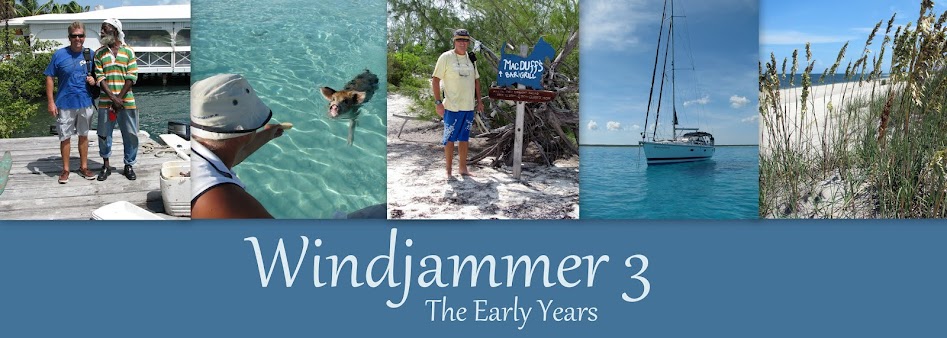It’s only a rum bar away…: 16 Sep 08
 |
| Hog Island |
Our next stop was Clark’s Court Bay; again through a narrow channel beside some hefty coral reefs. This time we found a much larger bay with any number of relatively secluded anchorages. Actually, the Motleys spent more time motoring about trying to decide which one was the “perfect” location than it took to actually get to it! Finally, we dropped the hook near Petit Calivigny in 28ft of green murky water and MUD….. It was here that the Cap’n cleaned our catch! Yes, BW had done it again. A nice big tuna, cut into steaks to put on the bbq. Yum oh!
 |
| Catch of the Day |
The next morning, the Cap’n & GS checked out facilities at a friendly marina and little town of Woburn. Again, it was very rural; very lush with small household gardens flourishing madly. Breadfruit trees were dripping with soccer ball sized fruits, paw paw and mango trees decorated almost every garden; seasonal okra were ready to pick and passionfruit vines ran over fences just laden with ripening, yellow fruit.
We eventually found a small grocery store, bypassing several rum shops, including the famous Nimrods, on the way. Even though the cruising community was well represented in all anchorages, we were struck again by low season blues - little was open. So, no washing or eating unless we moved on…
Clark’s Court Bay was used in the old days by sailing ships to load cargoes of spices and rum. This history continues in a way, given Woburn’s many little rum bars. Sometimes, these bars are little more than a shady spot with a stool or two and a killer “top shelf” selection. The better ones might have a telly – tuned to the cricket of course! Anyone wanting to know more about rum should follow up on the Ministry of Rum, an interesting site. All islands seem to have their own special brew, but here’s our favourite tipple or two. Cheers!
 |
| Grocery Store, Woburn |
‘Ti Punch (petit or small). Try 1½ white rum (rhum agricole, mes amis), ¼ sugar cane juice and ¼ lime juice mixed into a shot glass. Drink quickly (the taste is awful). The follow-up (if you’re still breathing) is called a cinq pou cent (literally 5%)…meaning half of the first. We tried it first in Iles des Saintes. Brave.
Planteur Punch. A mix of rum & fruit juice over ice. To my dismay, our Cap’n took a liking to my hard-to-find ruby grapefruit juice and for reasons of incrimination, he refuses to share his mix ratio. Try filling a glass with ice and adding 4 fruit juice, 2 rum, & 1 of lime juice. Add a sprinkle of nutmeg &/or Angostura Bitters depending upon your choice of juice.
Painkiller. The GS became fond of this one, but the Crew refused to make it up until after dinner….otherwise dinner prep was not taken as seriously as it should! His recipe is to mix 3 pineapple juice, 1 orange juice, 2 rum (authentic BVI mix uses Pusser’s) & 1 coconut cream over ice. Garnish with nutmeg.
From:St David’s Harbour, Grenada Lat/Long: 12 01N 61 40W Date/Time: 16/9/08: 1500
To: Clarke’s
Court Bay, Grenada Lat/Long: 12 01N 61 44W Date/Time:
16/9/08: 1600
Time Taken:
5nm (1hrs) Distance (this year): 751nm (158hrs)
Distance Total (since 2008): 751nm
(158hrs) Fastest Speed: Motored**
Weather:
Winds ESE 5-10kts; 2-4ft swell; fine day with a few clouds
(** Who cares – we caught a
tuna on the way!)
 |
| Sunset with Sundowners |






































